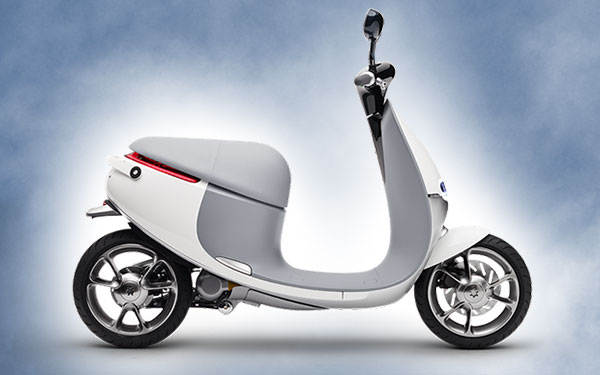Gogoro on Monday took to the stage at CES to unveil a zero-emissions electric scooter. The Smartscooter is designed to be powered by batteries available via subscription from a network of vending machines in urban areas around the world.
Equipped with 30 onboard sensors, cloud connectivity and an integrated mobile app, the Gogoro Smartscooter allows users to take advantage of features such as adaptive throttle control and customized regenerative braking, receive detailed scooter diagnostics — and find the closest battery-vending GoStation.
Riders also can track details such as the top speed and range of any given ride, enabling them to analyze patterns in order to optimize power and energy consumption.
Gogoro plans to ship its first product this year and is targeting “megacities worldwide,” company spokesperson Megan Zaroda told TechNewsWorld.
Eventually, other devices will integrate into Gogoro’s battery network as well.
“Gogoro is developing ways for the batteries to be bundled to power individual data servers and homes,” Zaroda said. “It’s truly portable power.”
Gogoro raised US$150 million in funding during its stealth period over the past four years. Pricing plans have not been disclosed.
A Customized Ride
Gogoro’s Smartscooter targets “hip, young urbanites” aged 18 to 28, Zaroda said. It is powered by an ultracompact G1 electric motor. Its lightweight Aeroframe monocoque chassis is made from racing-grade aluminum; a smart lighting system features programmable LEDs.
With a maximum speed of 95 km/hour, the Smartscooter can reach 50 km/hour in just 4.2 seconds, Gogoro said.
Designed for customizability, the vehicle allows riders to choose the specific ride feel and throttle acceleration, the dashboard-screen color spectrum, and the lock-and-unlock audio and lighting themes, for example. A variety of practical and design-oriented accessories add extra functionality and customized body details.
The Gogoro Battery uses cylindrical 18650-size automotive-grade lithium-ion energy cells from Panasonic. It features near-field communication connectivity and 256-bit security encryption. Each fully charged battery provides up to 100km of travel.
A monthly subscription plan will include unlimited battery swaps — a process that takes just six seconds — as well as roadside maintenance for two years, Zaroda said.
Location, Location, Location
“Being in Minnesota, currently with a -25F wind chill, I am not sure smart scooters will work everywhere,” said David Levinson, a transportation analyst and professor at the University of Minnesota.
However, “in the markets where they do work, battery swapping is good idea, and six seconds would be very fast,” he told TechNewsWorld.
Gogoro’s big challenge will be deploying its network of swapping stations, “since if they are not near where you are already going, they may not be of much use,” Levinson said.
“In other words, unless GoStations are as ubiquitous as gas stations, swapping will remain inconvenient for many potential users,” he pointed out.
“We will need to see a shipping product before we can really determine whether and how well this works,” added Levinson, “but I wish them good luck and hope they can find a viable deployment path with upfront capital expenses and sell their product.”
The HTC Factor
Sony, Michelin, Nike and Samsonite are among the other companies that have researched this space, said Vishwas Shankar, program manager for automotive and transportation at Frost & Sullivan.
“Gogoro is aggressive and potentially aims to join the major league with their micro-mobility model,” he told TechNewsWorld.
Gogoro’s speed capabilities — which are roughly 50 percent higher than those of its competitors — may help to set it apart, Shankar noted.
In terms of its engineering, “it appears like HTC is written all over it,” he added, noting the presence of multiple former HTC engineers on Gogoro’s team.
“Overall, Gogoro has all the ingredients, including the performance tag, to call themselves the ‘Tesla of the e-scooters’ with this innovative model,” Shankar said.
A Deal With Tesla?
“Success is a matter of timing, isn’t it?” mused Glen Hiemstra, founder of Futurist.com.
“In 2006, I test rode the all-electric scooter Vectrix at a motorcycle show in Milan,” he recalled. “I thought they had a good chance — but no.”
However, Gogoro has a better chance for three reasons, Hiemstra told TechNewsWorld.
First is better financial backing; second is better design, as it’s “more a true, modest scooter than a motorcycle look or intent,” noted Hiemstra. Third, it benefits from “much better consumer awareness of electric everything in 2015, and better infrastructure.”
It’s not clear Gogoro needs the battery-swapping plan, he noted, “except for replacing worn out — not just out-of-juice — batteries.”
In any case, “they should do a deal with Tesla where they give one away with each Tesla sold,” Hiemstra suggested.
“A friend just bought his spouse a scooter here in Seattle,” Hiemstra noted. “I’ll bet he may wish it was a Gogoro when it launches this year.”






















































